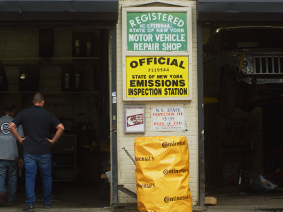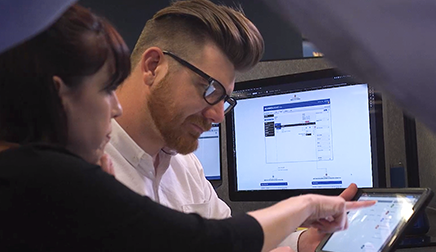Radar Sensing Technology
Radar – really? If you haven’t seen it in a crunched car yet, you are probably overdue. Vehicles utilizing this technology invented for ships and planes are now rolling (or being towed) into shops as a result of collisions. To repair these vehicles efficiently and profitably, you need to understand the specific nuances of each manufacturers’ advanced systems for collision avoidance, adaptive cruise control and parking assist.
As with any new system that proves successful, radar technology is sure to become widespread throughout the industry. The safety and convenience factors are simply too great. The National Transportation Safety Board already recommends that all new cars include collision avoidance and adaptive cruise control systems.
There may come a day when some emerging new technologies replace or augment today’s radar systems. The only thing certain is that vehicles will continue to become more and more complex, and manufacturers’ information is essential to repairing them safely and properly.
Below – as an example only -- is a partial and condensed description of the radar technology available in current Mercedes Benz® models.
Always refer to ALLDATA® Collision(SM) for safety procedures, identification of material types, recommended refinish materials, removal and installation procedures. Always refer to the manufacturer for questions relating to applicable or non-applicable warranty repair information
GF30.30-P-3301LEB Component Description For Radar Sensors Control Unit
MODEL 216.3, 221.0 /1 up to 31.8.10 with CODE (234) Blind Spot Assist as of model year 2009 / YoM 08
MODEL 221.0 /1 (except 221.095 /195) with CODE (239) Autonomous intelligent cruise control Plus Light as of model year 2011 / YoM 10
MODEL 221.095 /195 with CODE (234) Blind Spot Assist as of model year 2011
Model 221 N62/1Radar sensors control unit (SGR) (Figure 1)
Location: bottom right side of the luggage compartment.
Task: The radar sensors control unit is the evaluation unit of the short range radar for vehicles with the following equipment installed:
- Code (233) Distronic Plus
- Code (234) Blind Spot Assist
The radar sensors control unit also evaluates data from the long range radar for vehicle with the following equipment installed:
- Code (233) Distronic Plus
- Code (239) Adaptive cruise control Plus Light
To do this the radar sensors control unit fulfills the following tasks:
- Reading in of sensors, pickups and signals
- Evaluation of input factors
- Control of systems
- Output of signals
Reading in of sensors, pickups and signals
The input factors are read in via the following connections:
- Chassis CAN (CAN E)
- Vehicle dynamics CAN (CAN H)
- Sensor CAN (CAN S)
Chassis CAN
The radar sensors control unit reads in the following information via the chassis CAN:
- Status of the accelerator pedal
- Status of the engine timing
- Drive position status
- Electronic Stability Program (ESP) status
- Yaw rate status
- Wheel speeds and wheel rotation direction
- Status information from the driver assist or driving safety system
- Parking brake status
- Status of steering angle
- Position data from navigation (for the Western Europe version)
- Driver request via CC [TPM] push button (S40/4)
- Driver request via menu settings in instrument cluster (A1)
- Status of the flasher (for code (234) Blind Spot Assist)
- Status of the trailer (for code (234) Blind Spot Assist and code (550) AHV)
Vehicle dynamics CAN
The signals from the following components are read in via the vehicle dynamics CAN:
- DTR controller unit (A89) (for code (233) DISTRONIC PLUS or code (239) Adaptive cruise control Plus Light)
- Long range radar radar data
- Diagnostic data from long range radar
Sensor CAN
The signals of the following components are read in via the sensor CAN:
For code (233) DISTRONIC PLUS:
- Radar sensor on the inside left, front bumper (A86/1b2)
- Radar sensor on the inside right, front bumper (A86/1b3)
For code (234) Blind Spot Assist up to 31.8.09:
- Right inner radar sensor, rear bumper (A86/2b2)
- Left inner radar sensor, rear bumper (A86/2b3)
For code (234) Blind Spot Assist as of 1.9.09:
- Radar sensor on the outside right, rear bumper (A86/2b1)
- Radar sensor on the outside left, rear bumper (A86/2b4)
Evaluation of input factors: The input factors are evaluated by the integrated microprocessors and the relevant components are then actuated.
Due to the high performance of the radar sensors control unit, it is equipped with two microprocessors (clock frequency 40 MHz each).
Control of systems
- Variable Speed Limiter function (Speedtronic) (except code (494) USA version)
- Permanent Speed Limiter (winter tires)
- DISTRONIC PLUS (for code (233) DISTRONIC PLUS)
- Adaptive cruise control (for code (239) adaptive cruise control Plus Light)
- Automatic deactivation of the radar sensor system (for the Western European version)
- Blind Spot Assist (for code (234) Blind Spot Assist)
Chassis CAN
For code (233) DISTRONIC PLUS, the radar sensors control unit evaluates all input data and then takes on complete control of the vehicle's longitudinal movements, by sending signals for acceleration, deceleration and gear switching via the chassis CAN. Warning tones and display in the IC are also actuated by the radar sensors control unit and the PRE-SAFE measures are requested via the chassis CAN.
For code (234) Blind Spot Assist the radar sensors control unit actuates the left Blind Spot Assist readiness and warning indicator (M21/1e2) and the right Blind Spot Assist readiness and warning indicator (M21/2e2).
NOTE: This repair/service information is excerpted from information published by the vehicle manufacturer, and intended for the purpose of promoting OE collision repair information to trained, professional technicians with the knowledge, tools and equipment to do the job properly and safely. Before attempting any repairs described, refer to the complete article in ALLDATA Collision S3500. It is recommended that these procedures not be performed by “do-it-yourselfers.”
Dan Espersen, ALLDATA Senior Product Marketing Manager Collision, holds an AA Degree in Automotive Technology. He has 19 years of experience in the collision industry, and an additional 17 years in the automotive industry.
The ALLDATA Tech-Assist team fields cases like this every day. See how Tech-Assist can help your shop save time and money with on-call diagnostic support from ASE-certified Master Technicians. More Tech Tips
Not an ALLDATA customer? For access to this valuable experience-based repair data and reliable OEM information, start a free trial today.
If you would like to read more articles like this one please subscribe to ALLDATA News.







